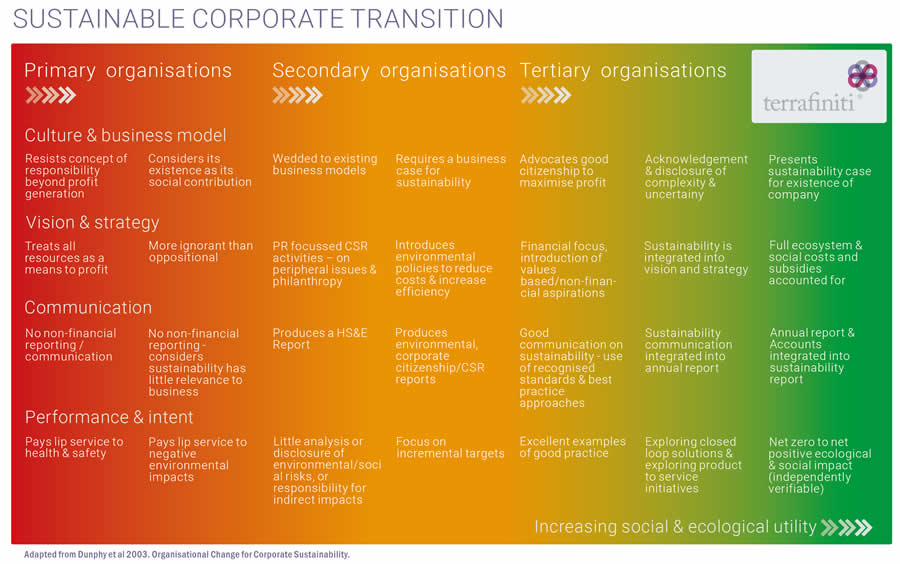Developing organisational capacity
In the long term, building a sustainable company often goes far beyond the role, if not the remit, of sustainability practitioners. It has long been recognised that to be successful, organisations must embed sustainability in their core activities with clear influence and effects across the entire value chain.

But this is easier said than done.
But how does an often isolated sustainability practitioner gain wider support and alignment? The key is developing capacity, processes and actions in four crucial areas:
- Leadership
- Ambition and Vision
- Plan structures and processes
- Developing people
Careful attention and hard work in these areas will help embed sustainability so it becomes a natural outcome of everyday business rather than a tiresome and uncertain additional activity.
Leadership
Engaging and mobilising leadership support is key to a sustainability approach that will move beyond compliance and deal with issues that drive risk and value. Where you begin depends upon the culture, approach and competitive strategy of your organisation. You can begin at the top, engaging receptive leaders with the business case for your company. The detail will vary according to circumstances but it will reside in 4 key areas:
- Revenues and earnings
- Costs
- Risk
- Intangibles
Your ideal leader will act as a role model, demonstrate leadership in sustainable culture and support action to develop and act upon the company’s vision for sustainability. You can foster and support your leaders to help build their understanding and achieve this. In addition, you can also engage and enthuse leaders by working from the ground up, canvasing the workforce provides a gauge of appetite for sustainable behaviour and an important reservoir of ideas and innovation.
Developing Ambition and Vision
Identifying sustainability ambition
Sustainability ambition defines and drives the level of your response, ranging from compliance through best practice to industry leading. Your ambition should closely fit the wider competitive and strategic approach of your business. It should be developed as an initial aspect of the development of a sustainability vision and involve representation from key staff across the business after considering business culture, your social and environmental material issues, key dependencies and risks.

We find that a good way to stimulate discussion and identify your company’s ambition for sustainability is to use a sustainability maturity matrix – sustainability is more fully embedded in company practice from left to right.
It’s a simple method, ask your colleagues the following questions:
- Where is your organisation located on the model above?
- Where would you like your organisation to be?
- When would you like us to get there?
Depending upon how you are gathering views of colleagues, you should look to identify the common themes and threads that emerge from their responses and collate these into a clear ‘place’ that they want the company to get to, and in what timescale (e.g. in 3 years, 5 years or 10 years).
Knowing where you want to get to is a fundamentally important for sustainability. It is the basis from which you can start to then focus upon developing a sustainability vision.
Developing sustainability vision
A company vision for sustainability is vital for communicating your purpose and intent both internally and externally. Vision should be developed and owned across the organisation and should be closely related to core business fundamentals. It should indicate a clear direction of travel and be capable of assessment (so that you can demonstrate the company is making progress).
The sustainability vison may be additional to a central company vision or simply reflected within it. It needs to encapsulate what sustainability means for the company, why it’s important, why it’s taking action and how it contributes to your value proposition.
Plan structures and processes
Driving sustainability requires making and managing change. However, many companies can stumble when it comes to moving from the exciting stage of establishing ambition and vision to the practical one of making that a reality. The scale of change required depends on how radical your vision is. However, at its heart, sustainability is about one of two things; doing the same things very differently or doing very different things.
Making sure your leadership understands the change implications of sustainability and is willing to provide consistent support through communications, resources and ensuring organisational understanding and commitment is vital.
The most successful organisations we have worked with build the ongoing improvement of sustainability performance into existing business management processes.
In practice this means a combination of two elements:
- Identifying how sustainability can be integrated into existing business processes – for instance supply contracts should clearly state the ethical and environmental standards that need to be met as a condition of business.
- Building systems and structures to support sustainability where required. These should focus around material (priority) issues, have clearly assigned responsibility, articulate commitments towards achieving the vision in a step by step fashion and have clear, associated KPIs for measurement and reporting.
Developing people
Your business is run by people, using their enthusiasm, skills and capabilities. Driving a change management process is likely to require an additional range of skills and capabilities – or a different distribution of them across the organisation. Successful companies pay close attention to capacity building and competency development of staff. In most cases this is best achieved by broadening and deepening the competencies of current staff to include understanding of the fundamental need to respond to critical environmental and social issues and how to build these as priorities within business processes as they evolve.
There is a growing range of thinking on what ‘sustainability skills and competencies’ include. At one level, some of the required skills are shared with other more traditional business roles, including communication, critical thinking, data interpretation, systems thinking and negotiation skills. At another level, certain areas of knowledge and expertise arise from the varied technical aspects of sustainability, such as understanding ecological systems or water cycles (for example) to the applied aspects such as developing a sustainability business case, engaging with stakeholders and meeting the requirements of sustainability reporting standards.
Professional bodies have provided overviews of sustainability skills, the ICRS (Institute of Corporate Responsibility and Sustainability) and IEMA (Institute of Environmental Management and Assessment) have produced a competency framework and a skills map, and these provide valuable guidance for assessing staff capacities.
Taking sustainability forward
Driving sustainability is a strategic issue and effective sustainability management recognises this. It is about long term economic success, and also about change. While this means the task of sustainability practitioners in companies is undoubtedly hard, and at times they may feel unsupported and isolated, a focus upon recruiting allies, and engaging leadership in the growing case for the business value of strategic sustainability is essential and ultimately rewarding.
We are experts at helping people develop and meet meaningful sustainable objectives. We can help you explain and drive your approach – contact our sustainability consultants.


Leave a Reply